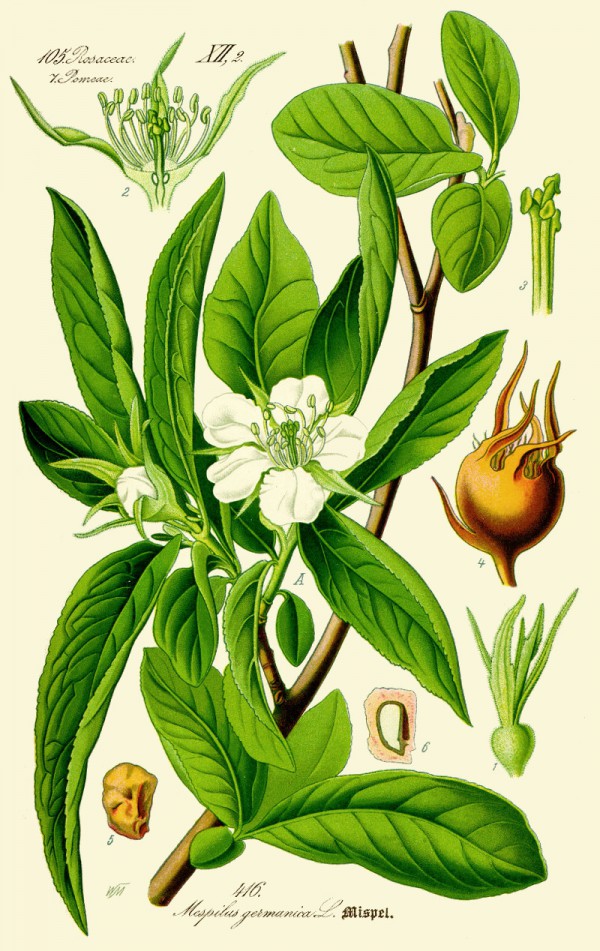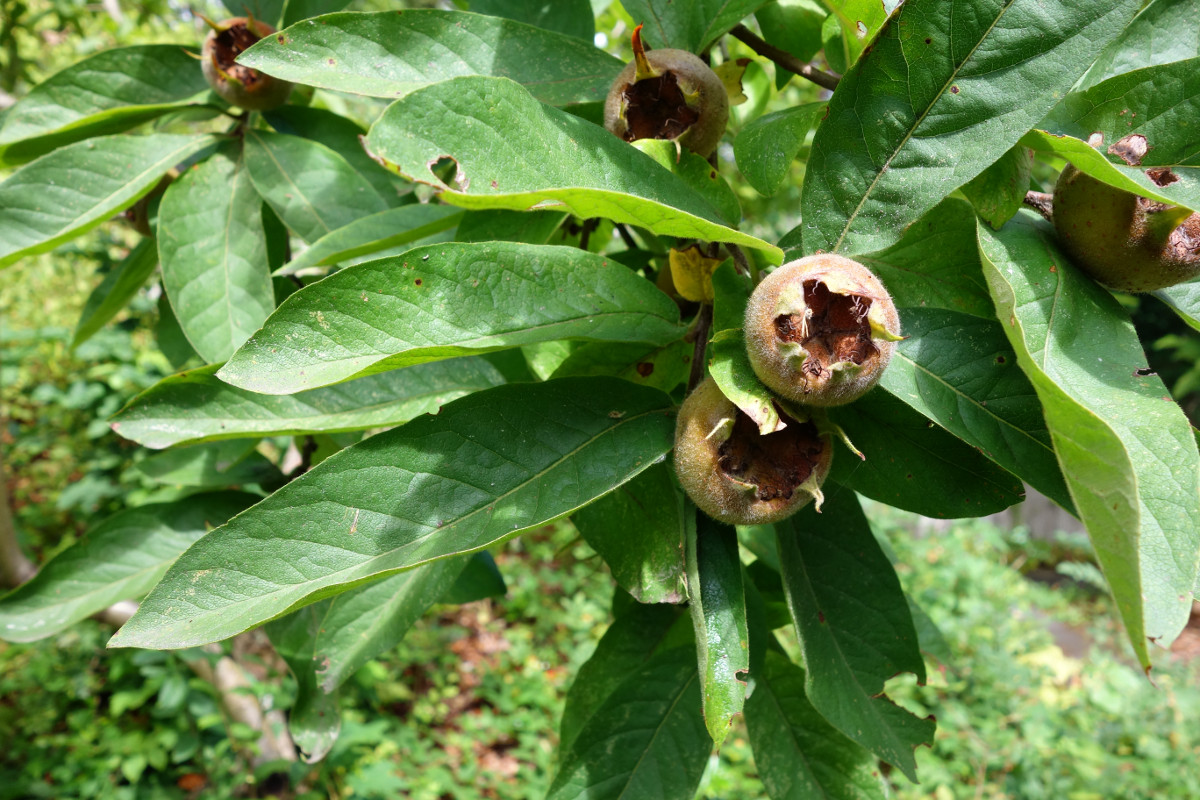Mespilus germanica L. - syn.Pyrus germanica (L.) Hook. f. - Rosaceae - medlar, Mispel
Small deciduous tree, up to 5m high, native to Eastern Europe and West Asia, widely cultivate in Europe in the middle ages; leaves lanceolate to ovate, margins entire to slightly crenate; flowers with orbicular petals, white to cream white; fruits are flattened globes with very distinct residual sepals and a slightly tomentose surface turning brown when ripe.
http://en.hortipedia.com/wiki/Mespilus_germanica
http://www.botgart.uni-bonn.de/o_samm/allmonatdet.php?id=71
https://de.wikipedia.org/wiki/Mispel
„The apple-like fruits develope their very special, tart-aromatic taste, by staying on the tree or after prolonged storage. Because jam or jelly can be made of, the fruit tree was previously widely used in Europe. By storing, tannins and fruit acids are broken down, sugar content increases and the fruits become soft, otherwise they are hard and astringent. Today, the medlar is rarely in culture.“ https://de.wikipedia.org/wiki/Mispel
„The most common use of medlar fruits is for raw consumption after bletting. The harvest of fruit bletted on the plant in late autumn or the harvest of fruits at physiological ripening and their storage in straw until over-ripening are well known traditions, still alive today. The bletted fruits (bletting: the ripening of fruit, especially of fruit stored until the desired degree of decay and softness is attained) have a sweet and slightly acid flesh. Jams and jellies can be obtained. In cookery, a surprisingly long list of recipes can be found. The astringency of the fruits has been well known since ancient times. Medlar bletted pulp or syrup was a popular remedy against enteritis (Bignami, 2000) and modern medicine has recognized (in the 1920s) its healing properties, to treat constipation, kidney and bladder stones and as a diuretic (Baytop, 1999)…
Fructose (1200mg/100g f.w.,ripe, skin completely brownish, pulp white), glucose (686mg/100g f.w.) and sucrose (219mg/100g f.w.) were the major soluble sugars. Total acid content of the fresh ripe fruit was 841mg/100g, with malic acid 428mg/100g, citric acid 404mg/100g and ascorbic acid 8.4mg/100g.
[Changes in sugars, organic acids and amino acids in medlar (Mespilus germanica L.) during fruit development and maturation., Glew, R.H., Ayaz, F.A., Sanz, C., VanderJagt, D.J., Huang, H.S., Chuang, L.T., Strnad, M., Food chemistry, 83(3), 2003, 363-369] http://www.sciencedirect.com/science/article/pii/S0308814603000979
„Medlar is the fruit of Mespilus germanica L. in the family of Rosaceae. The fruit can be eaten only if ‘bletted’ (softened by frost or longer storage). The effect of the maturation stages on the volatile compounds of the medlar fruit was investigated during two different stages. Volatile flavour substances were isolated from the minced pulp of unripe and full ripe medlar fruits by simultaneous steam distillation extraction (SDE) with methilen chloride as the extracting solvent. The concentrate was analysed by GC-FID-MS. Hexanoic and hexadecanoic acids were the predominant acids, hexanal and (E)-2-hexenal were the predominant aldehydes, (Z)-3-hexenol and hexanol were the predominant alcohols, with p-cymene, terpinen-4-ol, and γ-terpinene (the terpenes responsible for the characteristic medlar flavour) being also present. The C6 aliphatic compounds, such as hexanal and (E)-2-hexenal, were observed as the major volatile constituents in the green stage. In contrast, hexanol and (Z)-3-hexenol were the main volatiles in ripe fruits.“
[Volatile compounds in Medlar fruit (Mespilus germanica L.) at two ripening stages., Veličković, M.M., Radivojević, D.D., Oparnica, Č.Đ., Nikićević, N.J., Živković, M.B., Đorđević, N.O., Tešević, V.V., Hemijska industrija, 67(3), 2013, 437-441]

Thomé,O.W., Flora von Deutschland Österreich und der Schweiz, Tafeln, vol.3 t.416 (1885)
http://plantgenera.org/species.php?id_species=663580

Mespilus germanica, CC BY-SA 3.0, Author: Andreas Kraska
